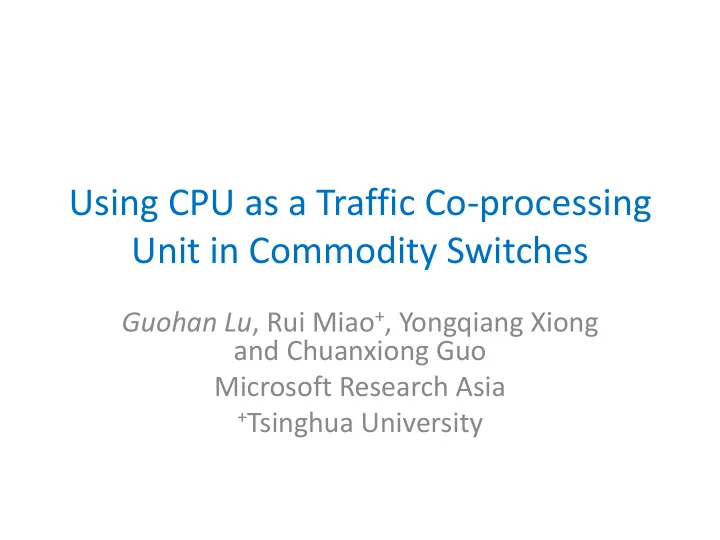

Using CPU as a Traffic Co-processing Unit in Commodity Switches Guohan Lu , Rui Miao + , Yongqiang Xiong and Chuanxiong Guo Microsoft Research Asia + Tsinghua University
Background • Commodity switches are the basic building blocks in enterprise and data center networks – PortLand and VL2 build entire DCN with 1U commodity switches
Background (cont ’) • Commodity switches now widely adopt single switching chip design CPU for control All-in-one plane DRAM switching ASIC • Greatly simplifies switch design and lowers down the cost
Limitation (I) • Limited forwarding table size for flow-based forwarding schemes, e.g. Openflow – Openflow provides finest granularity for better security (Ethane), traffic load balancing (Hedera), Energy saving (ElasticTree) – 4k flow entries for most recent BRCM switching chip Data center for map- reduce style applications with 120 ToR and ~5k servers # of active flows ≥ 4096 for 95%+ time 4k
Limitation (II) • Shallow packet buffer for bursty traffic – Switching ASIC has only several MB buffer – Bursty traffic pattern, e.g. TCP incast, TCP flash crowds – Packet drops lead to degraded network performance Senders Receiver R2 R0 R1
Design Goals • Large forwarding table – Support large forwarding table for forwarding schemes such as OpenFlow • Deep packet buffer – Absorb temporary traffic bursts, e.g., TCP incast, TCP flash crowds
Assumptions for Commodity Switches Multicore CPU for Large DRAM as off- packet processing chip packet buffer High speed interconnect as high speed data All-in-one switching ASIC channel Ethernet ports Future switch box
Large forwarding table software CPU fwd table hw fwd table Switch ASIC • Complete forwarding table in software • Partial forwarding table in hardware
TraFfic Offloading Ratio (TFOR) • TFOR: Traffic forwarded by HW v.s. all traffic • Obtain TFOR: For every minute, get flow rates, sort the flows based on the rates, put k fastest flows in HW. • TFOR ≥ 92% for 95%+ time when k = 4096
Flow Management • k fastest flows are forwarded by hardware, rest are forwarded by software • Assume one byte counter per flow in hardware • Procedures • Count software-forwarded flow bytes, periodically read the counters from hardware • Rank flows based on their rates and determine k fastest flows • Offload fast flows to hardware and onload slow flows to software
Deep Packet Buffer Internal high bandwidth CPU Channel Memory Memory Memory Switching Server Low watermark chip High watermark • Phase 1: Traffic redirection • Phase 2: Cancel redirection
Internal bandwidth Needed CPU 𝑒𝑏𝑢𝑏 = 2𝐷 data flow 𝑆 𝑗𝑜 𝑁𝑇𝑇 ≥2C ? ack flow 𝑒𝑏𝑢𝑏 = 𝐷 𝑆 𝑝𝑣𝑢 S 𝑁𝑇𝑇 R S 𝑏𝑑𝑙 = 𝐷 𝑆 𝑗𝑜 S 𝑁𝑇𝑇 Switch ASIC • Receiver: delayed ack disabled • Senders: TCP slow start • No packet drops when internal bandwidth is larger than 2C.
Prototype • A 16xGE port switch using 4 ServerSwitch cards • HP z800 workstation – 8 CPU cores 16xGE – 48GB DRAM 10GE • Kernel code for packet forwarding • User space code for switch ASIC management
Large Forwarding Table • 10 min synthesized traffic using flow size distribution from DCN S R measurements S R • 1,792 HW flow entries S R S R Interval Total bytes # of active TFOR ratio (GB) flows 1x 33.6 10,644 96.1% 1/10x 336 106,544 90.5%
Deep Packet Buffer S Requests S C 15 Servers Responses S TCP Flash Crowds last for 1 second 1024 SYN/ACK Data Fast Packet Requests timeout timeout Recovery drops TCP 109 180 690 15962 DCTCP 23 395 173 3302 DeepBuf 0 0 0 0
Conclusions • Two major limitations of current commodity switches – Limited forwarding table for Openflow – Shallow packet buffer for bursty traffic pattern • Use CPU as traffic co-processor to address these two limitations
QUESTIONS?
Recommend
More recommend